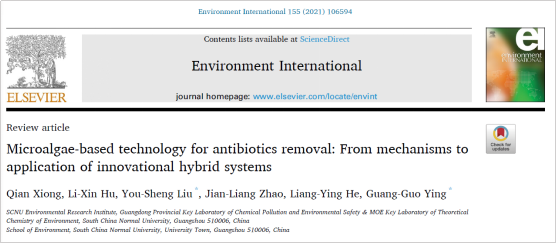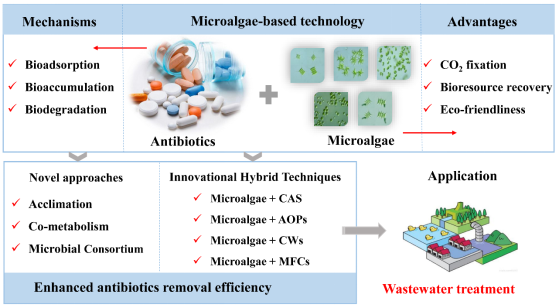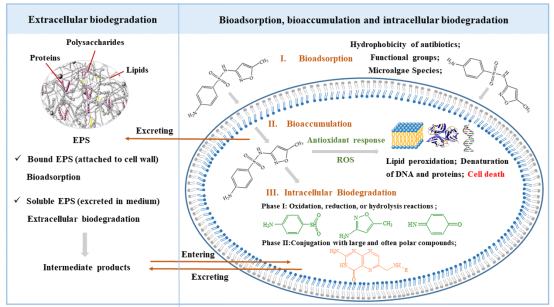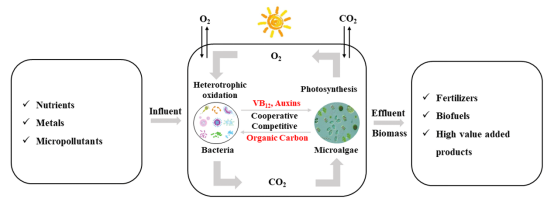Recently, Dr. Qian Xiong, a post-doctoral fellow from Professor Guang-Guo Ying’s group of SCNU Environmental Research Institute (SERI), published a review entitled “Microalgae-based technology for antibiotics removal: From mechanisms to application of innovational hybrid systems” in Environment International.

Graphic Abstract

Main Content
Antibiotics contamination is an emerging environmental concern, owing to its potential risks to ecosystems and human health. Microalgae-based technology has been widely reported as a promising alternative to conventional wastewater treatment, since it is a solar-power driven, ecologically friendly, cost-effective, and sustainable reclamation strategy. This review provides fundamental insights into the major mechanisms underpinning microalgae-based antibiotics removal, including bioadsorption, bioaccumulation, and biodegradation. The critical role of extracellular polymeric substances on bioadsorption and extracellular biodegradation of antibiotics are also covered. Moreover, this review sheds light on the important factors affecting the removal of antibiotics by microalgae, and summarizes several novel approaches to improve the removal efficiency, including acclimation, co-metabolism and microbial consortium. Besides, hybrid systems (such as, microalgae-based technologies combined with the conventional activated sludge, advanced oxidation processes, constructed wetlands, and microbial fuel cells), and genetic engineering are also recommended, which will be feasible for enhanced removal of antibiotics. Finally, this review also highlights the need for further studies aimed at optimizing microalgae-based technology, with emphasis on improving performance and expanding its application in large-scale settings, especially in terms of technical, environmental-friendly and economically competitiveness. Overall, this review summarizes current understanding on microalgae-based technologies for removal of antibiotics and outlines future research directions.
Introduction
Antibiotics are substances with antibacterial, anti-fungal, or anti-parasitical activity, which are extensively used in humans and animals for prevention and treatment of infectious diseases, as well as in livestock industries for growth promotion purposes. However, antibiotics administrated by humans or animals which can be metabolized or absorbed account for a small fraction, and approximately 50-90 percent of them are excreted via urine and feces, as a mixture of parent and metabolite forms. Consequently, released antibiotics and their metabolites subsequently enter into surrounding environments through multiple pathways, including wastewater treatment plants (WWTPs), runoff from fields into surface waters, hospitals, livestock farms, aquaculture farms, and pharmaceutical industries. Although relatively low concentrations were observed for most antibiotic residues in the environment, mounting evidences have demonstrated that they could induce adverse ecological effects on target- and non-target organisms, such as inhibiting the growth of microbes, altering microbial community composition and activities. Meanwhile, overuse and misuse of antibiotics could promote development and spread of antibiotic-resistant bacteria (ARB) and antibiotic resistant genes (ARGs), creating a strong selection pressure on human and natural microbial systems. Recently, microalgae-based technology has gained scientific attention for wastewater treatment, due to its unique advantages. Specifically, this review provides an in-depth description of the potential mechanisms involved in microalgae-based antibiotics removal, and recommends several novel approaches and hybrid techniques that can be employed to promote the removal efficiency of antibiotics and improve practical feasibility of microalgae-based technology for wastewater treatment.
Guided Reading

Figure 1 Mechanisms involved in the removal of antibiotics by microalgae.
Previous studies demonstrated that the removal of antibiotics caused directly by microalgae mainly include bioadsorption, bioaccumulation, and biodegradation (Fig 1). Bioadsorption occurs when antibiotics are either absorbed into cell wall of microalgae, or onto organic substances, such as extracellular polymeric substances (EPS), excreted by microalgae into their surrounding environments. Generally, lipophilic compounds (log Kow > 5) have high bioadsorption affinity values to microalgae due to electrostatic interactions, while hydrophilic compounds exhibit low bioadsorption affinities and are more persistent in growth medium. Bioaccumulation is an active metabolic process for uptake of antibiotics in living microalgal cells. Moreover, the accumulated antibiotics in microalgal cells might stimulate overproduction of reactive oxygen species (ROS). Due to their strong oxidative properties, ROS can not only lead to the oxidation of antibiotics, but also induce DNA and proteins denaturation, and cause cellular damage, mutagenesis and cell death. On the other hand, microalgae may deplete accumulated antibiotics in cells via metabolism with a series of complex enzymatic reactions, suggesting that accumulation can be seen as a pre-step for biodegradation. Microalgae-mediated biodegradation of antibiotics generally involves extracellular and intracellular biodegradation, or a combination of both where initial degradation occurs extracellularly, and the breakdown products may be further metabolized intracellularly. Intracellular degradation relies on ROS and various enzymes, while extracellular degradation depends on excretion of EPS by microalgae.

Figure 2 The interaction modes between microalgae and bacteria.
As some antibiotics are biorecalcitrant, improving the response of microalgae for wastewater treatment can be achieved by acclimating microalgae under harsh or limiting conditions. Acclimated microalgae show higher tolerance and biodegradation capacity than wild-type microalgal species, and guarantee better removal of contaminants. On the other hand, addition of organic substrates or other nutrient substances to form a co-metabolic system is an effective strategy for promoting microalgae-mediated biodegradation of persistent organic contaminants. Besides acclimation and co-metabolism, recent studies have reported the potential application of microalgal consortium in wastewater treatment with a cost-effective and environment-friendly manner (Fig 2). A detailed comparison between microalgae-microalgae consortium and microalgae-bacteria consortium is summarized in main text, especially in terms of interactions established between the microorganisms, as well as main characteristics, cost and applications of the two consortium. Additionally, hybrid systems, such as microalgae-based technologies combined with the conventional activated sludge, advanced oxidation processes, constructed wetlands, and microbial fuel cells, are also recommended, which have emerged as promising approaches for antibiotics removal in wastewater treatment.
Generally, microalgae exhibit species-specific preference and tolerance to surrounding environments, as well as specific performance for the biodegradation of different antibiotics. In this context, prospecting for suitable microbial strains is a crucial first step towards constructing a stable microalgae-based system for continuous and efficient removal of pollutants from wastewater. High-throughput sequencing technique provides insight to analysis of the microbial community structure, functions and dynamics in the microalgae-based system, as well as isolation of microbes with capacity for efficient biodegradation of micropollutants. Besides, genetic engineering has also been used to exploit engineered microbial strains or consortium, aiming at improving the specific metabolic activities of microbes or enriching microbes with specific functionality. Although microbes modified by genetic engineering show highly biodegradation capacity of micropollutants in lab-scale reactors, their application in WWTPs remains controversial.
Perspectives
Over all, given the diversity of antibiotics pollutants and the complexity of realistic pollutant environments, several challenges with respect to the improvement of the removal capacity, revelation of inner molecular mechanisms, development and application of hybrid systems, removal of ARGs and ARB, as well as toxicity investigation of effluents remain to be addressed and need more attention. Details are as follows:
1) Although the biodegradation mechanisms of antibiotics have been widely investigated by previous studies, which are not fully understood, especially at the molecular level;
2) Even though omics technologies have emerged as promising molecular tools, the application of uni- or multi-omics approaches in wastewater bioremediation mechanisms is still in its infancy and critical overview of these technologies used to date is limited;
3) Further efforts should be focused on the application of genetic engineering technology in on-site reactors at WWTPs, and on risk assessment of gene modification such as the transfer of ARGs, to broaden their application in wastewater bioremediation;
4) Studies regarding microalgal consortium and hybrid technique in wastewater treatment are generally performed in laboratory scale units, further studies are needed to expand the application of consortium and different hybrid systems, with regards to efficiency of removal of ARGs and ARB in addition to targeted antibiotics, as well as the toxicity of effluents.
The published article is listed as follows:
Qian Xiong, Li-Xin Hu, You-Sheng Liu*, Jian-Liang Zhao, Liang-Ying He, Guang-Guo Ying*, 2021. Microalgae-based technology for antibiotics removal: From mechanisms to application of innovational hybrid systems. Environment International, 155, 106594.
Link for full-text: https://doi.org/10.1016/j.envint.2021.106594